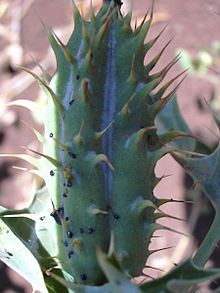Papaveraceae
| Papaveraceae | |
|---|---|

| |
| Papaver rhoeas | |
| Scientific classification | |
| Kinrick: | Plantae |
| (unranked): | Angiosperms |
| (unranked): | Eudicots |
| Order: | Ranunculales |
| Faimily: | Papaveraceae Juss. |
Papaveraceae papavə'rese, informally kent as the puppie faimily, is an economically important faimily o 30 genera an aboot 600 species o flouerin plants in the order Ranunculales. The faimily is cosmopolitan, occurrin in temperate an subtropical climates, but almaist unkent in the tropics. Maist are yerbaceous plants, but a few are shrubs an smaa trees.
Description
[eedit | eedit soorce]
The plants mey be annual, biennial, or perennial. Uisually yerbaceous, a few species fairm scrogs or evergreen trees. Thay are lactiferous, producin latex, whilk mey be milky or wattery, coloured or plain. Aw pairts contain a weel-developed duct seestem (thir ducts are cried "laticifers"), producin a milky latex, a wattery white, yellae or reid juice.
The semple leaves are alternate or whiles whorled. Thay hae petioles an are nae enclosed bi a sheath. The leaves are uisually lobed or pinnatifid (i.e. consisting o several nae entirely separate leaflets), or much-dividit. Thare are no stipules.
The plants are hermaphroditic an are pollinatit maistly bi insects (even as flouer nectaries are lackin; entomophilous), a few bi the wind (anemophilous). Thare is a distinct calyx an corolla, except in Macleaya whaur the corolla is lackin. The flouers is medium-sized or lairge an thay leuk spectacular. The terminal flouers solitar in maist species. In ithers the terminal inflorescence is cymose or racemose. The flouers is odourless an regular.
Thare mony stamens, maistly 16 tae 60, arranged in twa separate whorls, the ooter ane wi stamens alternate wi the petals, the inner ane opposite. The gynoecium consists o a compound pistil wi 2 tae 100 carpels. The ovary is superior an 1-locular. The ovary is athoot a footstalk (sessile) or on a short stem (stipitate).
The non-fleshy fruit is uisually a capsule, breakin open at maturity tae release the seeds throu pores (poricidal), or throu the partitions atween the cells (septicidal), or bi means o valves (valvular). The numerous seeds is smaa. Thair nutritive tissue (endosperm) is oily an farinose. The fruit o Platystemon is a schizocarp. Naur aw o thir plants contain alkaloids. Mony are pushionous. The Mexican Prickly puppie is pushionous if taken internally an mey cause edema an glaucoma. Even gif an ainimal, lik a gait, shoud persist in grazin on this plant, nae anly will the ainimal suffer but the lik will be for thaim that drink its milk, acause the pushions is passed alang in the milk.
Taxonomy
[eedit | eedit soorce]The APG II seestem (2003; unchynged frae the APG seestem o 1998) places the faimily in the order Ranunculales, in the clade eudicots. Housomever, APG daes provide for the option tae segregate twa faimilies, as optional segregate. Sicweys, thare twa possible circumscriptions:
- Papaveraceae sensu lato, includin the plants that wad itherwise fairm the faimilies Fumariaceae an Pteridophyllaceae. (see subfaimilies)
- Papaveraceae sensu stricto, excludin thir plants.
The faimily sensu stricto confairms tae the faimily as recognised bi the Cronquist seestem, o 1981 (Cronquist recognised Fumariaceae as separate). This comprises aboot 26 genera an aboot 250 species. The description gien abuin applies tae the faimily in this narra sense.
- Genera in Papaveraceae sensu stricto


|
|
The single genus transferred whan Pteridophyllaceae is includit in Papaveraceae is :
The 20 genera transferred whan Fumariaceae is includit in Papaveraceae are :
Subfaimilies
[eedit | eedit soorce]For discussions o subfaimilies, see Carolan et al. (2006) an Blattner an Kadereit (1999): Eschscholzioideae, Papaveroideae (includin Platystemonoideae), an Chelidonioideae.
The twa taxa considered subfaimilies that hae been considered as separate faimilies is the Fumariaceae (Bercht. & J. Presl, 1820) an the Pteridophyllaceae (Murb., 1912) Nakai ex Reveal & Hoogland, 1991.
Cultivation
[eedit | eedit soorce]The faimily is weel luved for the strikin flouers, wi mony species grawn as ornamental plants, includin Californie puppie (Eschscholtzia californica, the Californie state flouer), the stunnin blue Himalayan poppies (Meconopsis), several species o Papaver, an the wildflouer bloodruit. The faimily conteens the opium puppie (Papaver somniferum) an aw, whilk is the soorce o opium an opiates, as weel as puppie seeds uised in cuikin an bakin, an puppieseed ile.
Seembolism
[eedit | eedit soorce]The opium puppie an corn puppie is seembols, respectively, o sleep an daith. In Great Breetain, Canadae, the Unitit States, an Australie the corn puppie is worn in remembrance o Warld War I.
References
[eedit | eedit soorce]Freemit airtins
[eedit | eedit soorce]| Wikimedia Commons haes media relatit tae Papaveraceae. |
- Papaveraceae in Topwalks Archived 2014-07-06 at the Wayback Machine
- Papaveraceae Archived 2006-03-20 at the Wayback Machine [sensu stricto] in L. Watson an M.J. Dallwitz (1992 onwards). The families of flowering plants Archived 2007-01-03 at the Wayback Machine.
- Papaveraceae [sensu lato] in the Flora of North America
- NCBI Taxonomy Browser [sensu stricto]
- links at CSDL Archived 2008-02-03 at the Wayback Machine
- Family Papaveraceae Archived 2012-10-11 at the Wayback Machine Flowers in Israel
- *JAMES C. CAROLAN, INGRID L. I. HOOK, MARK W. CHASE, JOACHIM W. KADEREIT and TREVOR R. HODKINSON. Phylogenetics of Papaver and Related Genera Based on DNA Sequences from ITS Nuclear Ribosomal DNA and Plastid trnL Intron and trnL–F Intergenic Spacers. Annals of Botany 2006 98(1):141-155
- Frank R. Blattner and Joachim W. Kadereit. Morphological evolution and ecological diversification of the forest-dwelling poppies (Papaveraceae: Chelidonioideae) as deduced from a molecular phylogeny of the ITS region. Plant Systematics and Evolution Volume 219, Numbers 3-4 / September, 1999 181-197[deid airtin]
